Rising food prices present a major challenge when it comes to school lunch programs that aim to roll out the healthiest menu possible for our kids.

MARSHALL – As food prices continue to rise across the nation, so could the cost of school lunches.
But despite challenging economic times, Taher Foods, Inc. and Marshall Public Schools are battling to strike a healthy balance, striving to provide students with a healthy variety of foods on a daily basis while still trying to manage the budget, keep prices reasonable for families and follow stringent government regulations.
“So much has changed since I started in food service,” Lori Fruin said of her 28-year career. After spending 10 years working in food service in Cottonwood, Fruin started working for Taher. She spent 14 years at Tracy Area Public Schools and the past four years at MPS, serving as director in both locations.
Taher has been the food service provider at MPS for 25 years. Mark Brodersen, vice president of operations, has been with Taher for 19 of those years.
“There’s so much that the government is changing,” Brodersen said. “It’s a little bit confusing and it’s a lot to absorb for smaller school districts.”
In alignment with President Obama’s signing of the Healthy, Hunger-Free Kids Act of 2010, first lady Michelle Obama launched “Let’s Move! pushing for healthier kids in America by demanding schools to serve less processed foods, more fruits and vegetables and more foods from scratch.
“It’s a battle because it’s more expensive to serve fresh foods,” Brodersen said. “But we’re committed to it. And, we don’t want to raise prices unless we have to. Food prices have been picking up steam lately. We’re seeing a 4 to 5 percent increase, and by next year, it could be around 8 percent. That’s really a challenge for us.”
Bruce Lamprecht, MPS director of business, said typically lunch prices at MPS have increased every other year. Last year, there was no increase, but there was a hike of 5 cents for the 2009-10 school year.
“The maximum we’ve ever raised in a one year is 10 cents and it’s usually more like 5 cents,” he said. “Our goal is for the food service program to break even. We don’t want to take money from the general fund. Prices depend on how the food service program did the previous year, whether they broke even, made money or lost money.”
The United States Department of Agriculture recently sent out memorandums, outlining section 205 of the Healthy, Hunger-Free Kids Act of 2010, which, effective July 2011, requires school food authorities that participate in the National School Lunch Program to ensure equity in school lunch prices for all students – those who qualify for free and reduced meals and those who do not.
“There’s a good chance that there will be an increase for a number of reasons,” Lamprecht said. “The cost of food prices, whether it be a vendor like Taher, a restaurant or a home kitchen, are increasing. That puts pressure on everybody, with the cost of fuel for delivery of supplies and for farmers to grow crops. All of that will have an inflationary impact.”
According to the Minnesota Department of Education, schools must raise prices by at least 5 cents, but not more than 10 cents, if its current school lunch price is between $1.60 and $2.45, which it is at MPS.
“There’s nothing carved in stone at this point,” Lamprecht said. “A recommendation could come forward in August. Then the board would decide what to do.”
In the meantime, Taher staff is dedicated to doing all they can to provide a variety of well-balanced meals. Much of what Taher has done the past few years – with the implementation of programs like Food 4 Life and Farm to School – is in alignment with newer government recommendations and regulations.
“Our Food 4 Life is a lot about adding more fresh fruits and vegetables in addition to canned ones,” Brodersen said.
For National Nutrition month (March), Fruin used an array of colorful fruits and vegetables for an “Eat Right With Color” display in the cafeteria, both educating and tempting for students. The past few years, MPS has used a variety of produce from local farmers as part of the Farm to School program.
“It’s easier to serve canned foods, but we want to provide students with healthy food that provides energy,” Brodersen said. “We’re trying to do our part to curb obesity in American youth.”
Fruin is especially excited about a new connection with Fountain Prairie Produce LLC for hydroponic-grown lettuce.
“I’m really excited about it, especially the Romaine lettuce,” Fruin said. “Everything on it is edible and you just have to cut off the root. I put in an order on Friday and the guy from Pipestone delivers it on Monday.”
Fruin said chicken tenders and mashed potatoes are still the favorite at MPS and that fresh pineapple disappears the fastest. Kids also like it when they get to head outside for a “grill out.” Students can choose from different meals every day, including a main entree ($2.10), grilled station or pizza ($3.05) or the chef’s meal ($3.80) which might be something like chicken alfredo. Included in each meal plan is bread, milk, soup and the fresh fruit and vegetable bar – including lettuce salad.
To be counted as a reimbursable meal, students have to have three of the five requirements: bread, milk, fruit, vegetable and protein. Students at the high school can also purchase extras, like french fries, chips, cookies, bars, granola bars or juice.
“It’s a process of educating the kids to make good choices,” Brodersen said. “There’s nothing wrong with having a chocolate chip cookie, but just not every day.”
Working from menu plans in a five-week cycle, Taher has gradually decreased availability of products with high fructose corn syrup, limited fat and sodium amounts and introduced healthier versions of certain foods.
“We started adding more whole wheat and whole grain,” Fruin said. “That’s all you can get from the government anymore, especially pasta. Kids notice that it looks different. It’s not as popular yet, but that’s the way the state wants us to lean.”
Fruin is also open to student input and meets with a committee once a month to address concerns.
By Jenny Kirk (jkirk@marshallindependent.com) , Marshall Independent
http://marshallindependent.com/page/content.detail/id/527211/The-lunch-crunch.html?nav=5015



